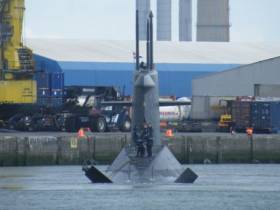Displaying items by tag: Dutch Navy Submarine
Dutch Navy's 'X' Stern Submarine to Visit Cork City
#X-Submarine - A Dutch navy non-nuclear powered submarine built during the Cold War is this afternoon arriving to Cork City for a four-day visit, writes Jehan Ashmore.
HNLMS Bruinvis is a diesel electric powered submarine. The 68m submarine is equipped with almost 40 torpedoes and is the final ‘Walrus’ class of four built. Leadship HNLMS Walrus visited Dublin Port earlier this year.
On this occasion, the visit of the Royal Netherlands Navy (NATO member) submarine takes place at Cork city centre’s JJ Horgan's Wharf on the north quays. The crew are to spend their on leave time in the southern city for the purposes of rest and recreation.
What makes these class unusual to other submarines is the "X" tail configuration design. This involves in mounting four combined rudders and diving planes to form the an "X" tail at the stern (see above photo).This differs to the conventional cross-shaped assembly of stern diving planes and rudders.
The contract for the submarine was given to Rotterdamsche Droogdok Maatschappij (Rotterdam Dry Dock Co). Construction began in 1988, one year before the fall of the Berlin Wall and the end of the Cold War in 1991. Three years later HNLMS Brunis was commissioned into service.
Dutch Navy Submarine Visits Cork City Quays
#SUBMARINE – A Dutch Navy submarine HNLMS Dolfijn arrived into Cork Harbour this morning, she is one of four 'Walrus' class which are among the modern sophisticated non-nuclear submarines in the world, writes Jehan Ashmore.
The Royal Netherlands Navy submarine which draws 7.5m draught berthed at Cork City's J.J. Horgan's Wharf which has a 8.8m depth. She is a sister of lead class submarine HNLMS Walrus which visited Dublin Port several years ago.
The class were built using stealth technologies making them invisible and very difficult to detect by ships, aircraft or other submarines when submerged. The submarines can remain submerged for long periods to carry out their missions.
'Walrus' class specifications: Length: 68 m Beam: 8.5 m Draught: 7.5 m Maximum diving depth: > 300 m Water displacement: 2,450 tonnes (surface), 2,800 tonnes (submerged) Propulsion diesel/electric: (3,132 kW) Maximum speed: 11 knots (surface), 20 knots (submerged) Ship's company: 55 Armament: MK 48 torpedoes
Dutch submarines in peacetime duties are used primarily for reconnaissance. During exercises, they are often used as targets for frigates and helicopters.
Should a nation not be cooperating with sanctions imposed by the international community, the submarines can contribute to enforcing the International sanctions. During the NATO Operation Allied Force, HNLMS Dolfijn helped to enforce the embargo off the coast of former Yugoslavia.
Among the other missions the submarines are involved include: collecting intelligence; conducting coast reconnaissance; laying sea mines and putting special forces from the Netherlands Marine Corps ashore.
On overseas deployments, for example HNMLS Dolfijn has patrolled in the Caribbean Sea with calls to the Netherlands Antilles capital of Willemstad.
























